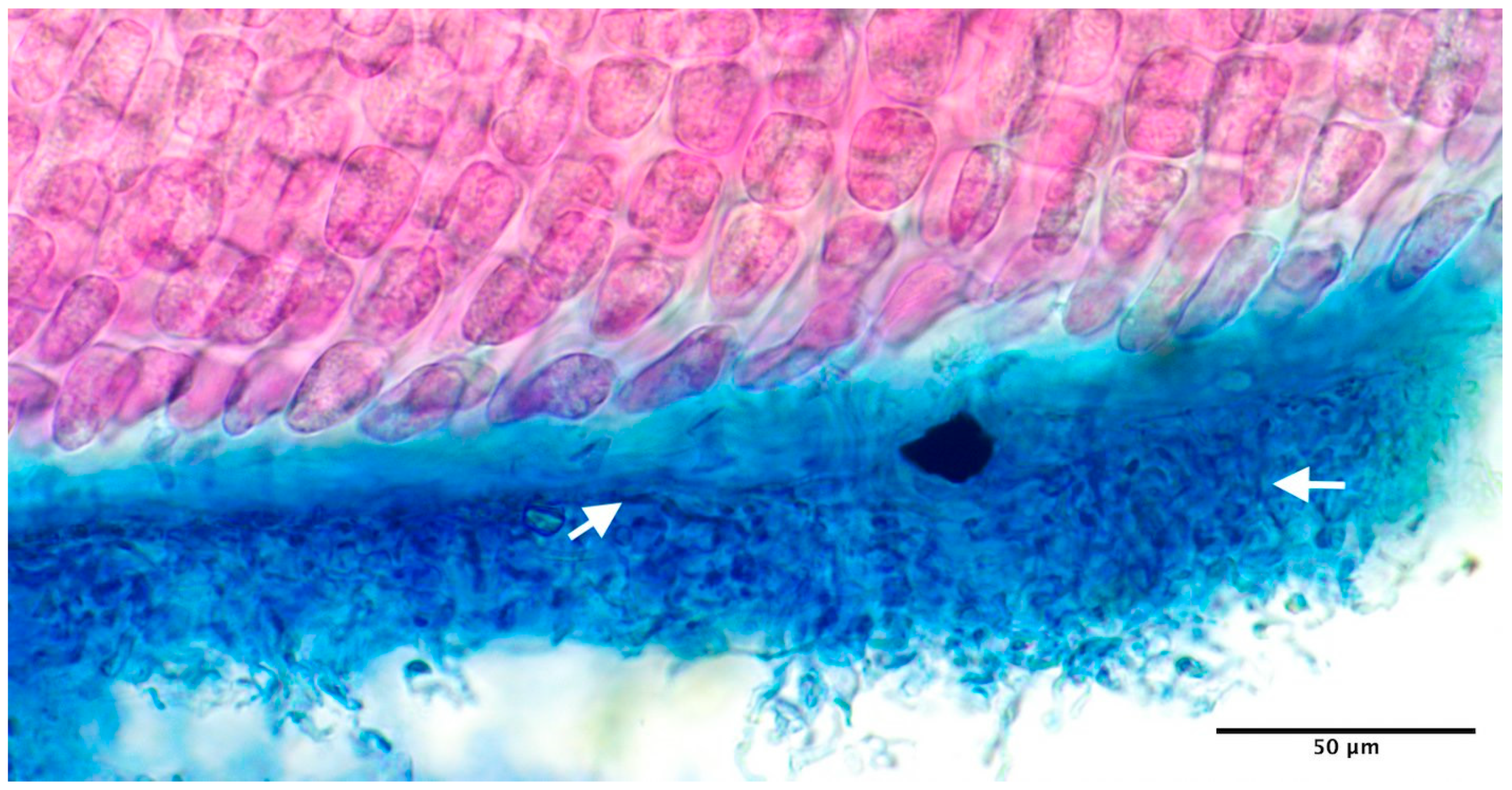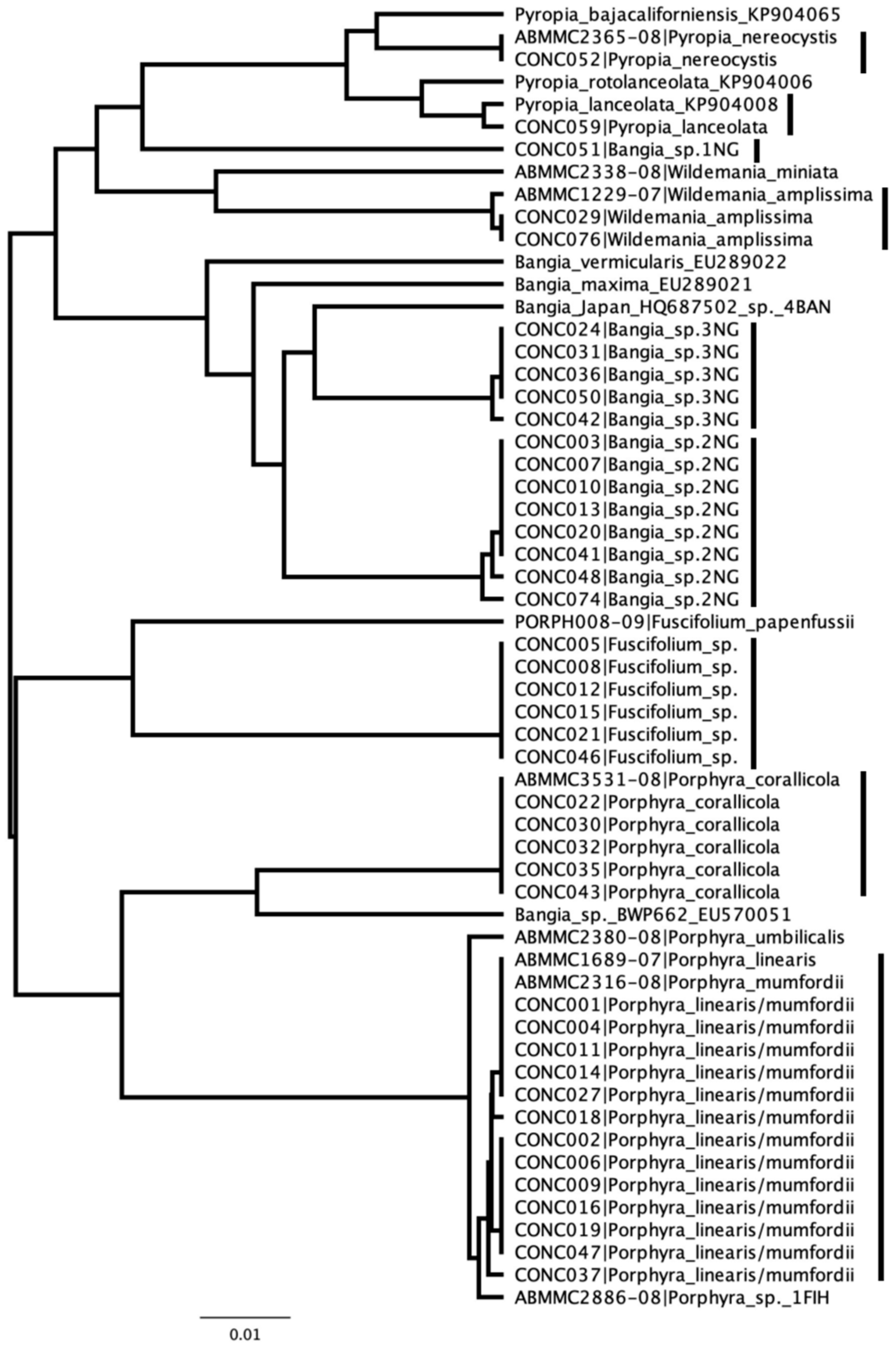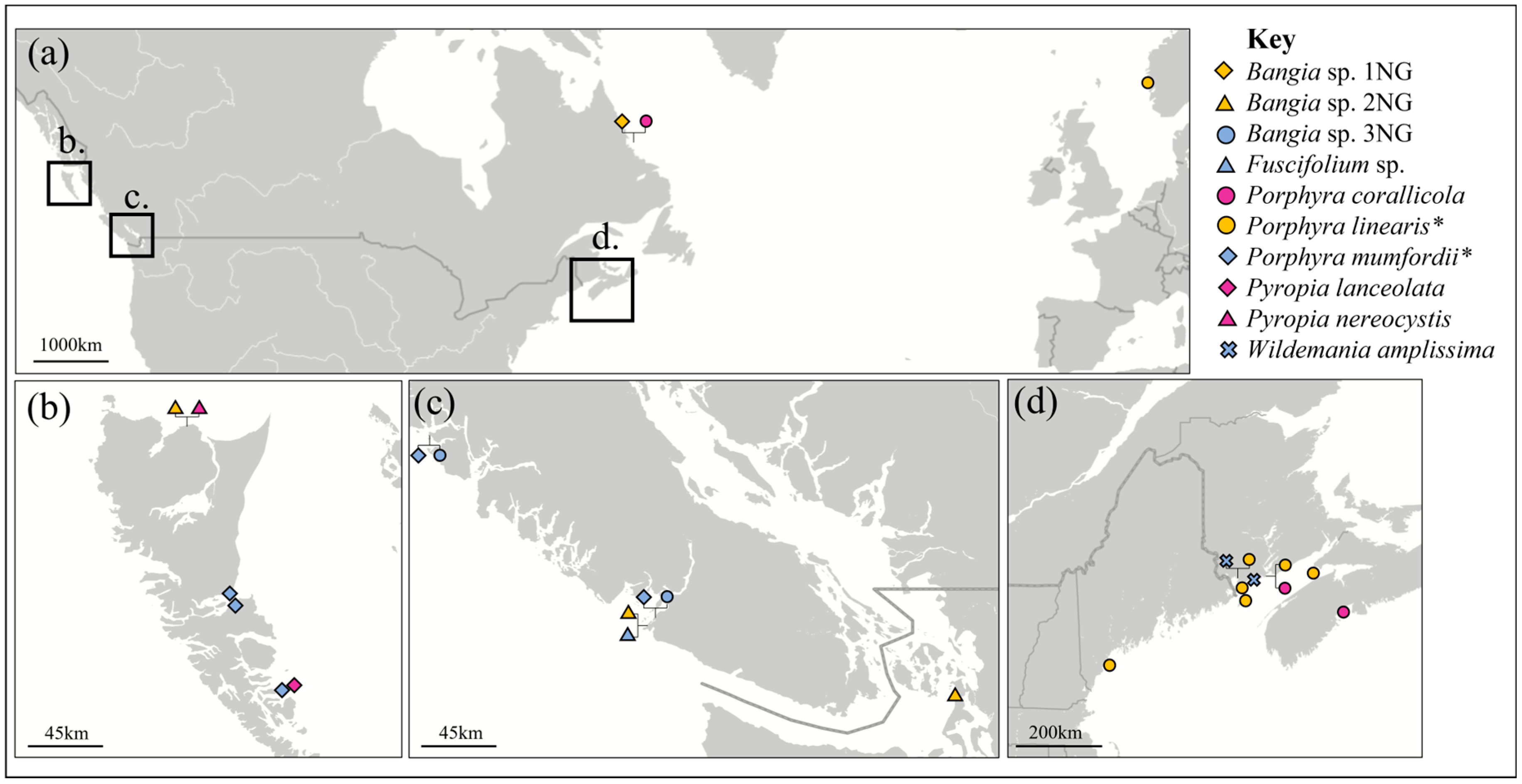Metabarcoding Extends the Distribution of Porphyra corallicola (Bangiales) into the Arctic While Revealing Novel Species and Patterns for Conchocelis Stages in the Canadian Flora
Abstract
1. Introduction
2. Materials and Methods
3. Results
4. Discussion
Supplementary Materials
Author Contributions
Funding
Institutional Review Board Statement
Data Availability Statement
Acknowledgments
Conflicts of Interest
References
- Sutherland, J.E.; Lindstrom, S.C.; Nelson, W.A.; Brodie, J.; Lynch, M.D.J.; Hwang, M.S.; Choi, H.G.; Miyata, M.; Kikuchi, N.; Oliveira, M.C.; et al. A new look at an ancient order: Generic revision of the Bangiales (Rhodophyta). J. Phycol. 2011, 47, 1131–1151. [Google Scholar] [CrossRef] [PubMed]
- Drew, K.M. Conchocelis-phase in the life-history of Porphyra umbilicalis (L.) Kütz. Nature 1949, 164, 748–749. [Google Scholar] [CrossRef]
- Tribollet, A.; Pica, D.; Puce, S.; Radtke, G.; Campbell, S.E.; Golubic, S. Euendolithic Conchocelis stage (Bangiales, Rhodophyta) in the skeletons of live stylasterid reef corals. Mar. Biodiv. 2018, 48, 1855–1862. [Google Scholar] [CrossRef]
- Drew, K.M. Studies in the Bangioideae III. The life-history of Porphyra umbilicalis (L.) Kütz. var. laciniata (Lightf.) J. Ag.: A. The Conchocelis-phase in culture. Ann. Bot. 1954, 18, 183–211. [Google Scholar]
- Peña, V.; Bélanger, D.; Gagnon, P.; Richards, J.L.; Le Gall, L.; Hughey, J.R.; Saunders, G.W.; Lindstrom, S.C.; Rinde, E.; Husa, V.; et al. Lithothamnion (Hapalidiales, Rhodophyta) in the Arctic and Subarctic: DNA sequencing of type and recent specimens provides a systematic foundation. Eur. J. Phycol. 2021, 56, 468–493. [Google Scholar] [CrossRef]
- Brodie, J.A.; Irvine, L.M. Seaweeds of the British Isles. Volume 1. Rhodophyta. Part 3B. Bangiophycidae; Intercept: Andover, UK, 2003; pp. i–xiii, 1–167. [Google Scholar]
- Kucera, H.; Saunders, G.W. A survey of Bangiales (Rhodophyta) based on multiple molecular markers reveals cryptic diversity. J. Phycol. 2012, 48, 869–882. [Google Scholar] [CrossRef]
- Bird, C.J. Aspects of the life history and ecology of Porphyra linearis. (Bangiales, Rhodophyceae) in nature. Can. J. Bot. 1973, 51, 2371–2379. [Google Scholar] [CrossRef]
- Bird, C.J.; Chen, L.C.-M.; McLachlan, J. The culture of Porphyra linearis (Bangiales, Rhodophyceae). Can. J. Bot. 1972, 50, 1859–1863. [Google Scholar] [CrossRef]
- Bringloe, T.T.; Saunders, G.W. DNA barcoding of the marine macroalgae from Nome, Alaska (Northern Bering Sea) reveals many trans-Arctic species. Polar Biol. 2019, 42, 851–864. [Google Scholar] [CrossRef]
- Bringloe, T.T.; Verbruggen, H.; Saunders, G.W. Unique diversity in Arctic marine forests is shaped by diverse recolonisation pathways and far northern glacial refugia. Proc. Natl. Acad. Sci. USA 2020, 117, 22590–22596. [Google Scholar] [CrossRef] [PubMed]
- Saunders, G.W.; Moore, T.E. Refinements for the amplification and sequencing of red algal DNA barcode and RedToL phylogenetic markers: A summary of current primers, profiles and strategies. Algae 2013, 28, 31–43. [Google Scholar] [CrossRef]
- Saunders, G.W.; McDevit, D.C. Methods for DNA barcoding photosynthetic protists emphasizing the macroalgae and diatoms. Methods Molec. Biol. 2012, 858, 207–222. [Google Scholar]
- Comeau, A.M.; Douglas, G.M.; Langille, G.I. Microbiome helper: A custom and streamlined workflow for microbiome research. Methods Protoc. 2017, 2, e00127-16. [Google Scholar] [CrossRef]
- Bolyen, E.; Rideout, J.R.; Dillon, M.R.; Bokulich, N.A.; Abnet, C.C.; Al-Ghalith, G.A.; Alexander, H.; Alm, E.J.; Arumugam, M.; Asnicar, F.; et al. Reproducible, interactive, scalable and extensible microbiome data science using QIIME2. Nat. Biotechnol. 2019, 37, 852–857. [Google Scholar] [CrossRef] [PubMed]
- Callahan, B.J.; McMurdie, P.J.; Rosen, M.J.; Han, A.W.; Johnson, A.J.A.; Holmes, S.P. DADA2: High-resolution sample inference from Illumina amplicon data. Nat. Methods 2016, 13, 581–583. [Google Scholar] [CrossRef] [PubMed]
- Martin, M. Cutadapt removes adapter sequences from high-throughput sequencing reads. Embnet. J. 2011, 17, 10–12. [Google Scholar] [CrossRef]
- Saunders, G.W.; Moore, T.E. Dataset—DS-BANGIAL1 Bangiales DNA Barcode Survey Data Release. 2023. Available online: http://www.boldsystems.org/index.php/Public_SearchTerms?query=DS-BANGIAL1 (accessed on 7 March 2023).
- Saunders, G.W.; Brooks, C.M.; Scott, S. Preliminary DNA barcode report on the marine red algae (Rhodophyta) from the British Overseas Territory of Tristan da Cunha. Cryptogam. Algol. 2019, 40, 105–117. [Google Scholar] [CrossRef]
- Guillemin, M.-L.; Contreras-Porcia, L.; Ramírez, M.E.; Macaya, E.C.; Contador, C.B.; Woods, H.; Wyatt, C.; Brodie, J. The bladed Bangiales (Rhodophyta) of the South Eastern Pacific: Molecular species delimitation reveals extensive diversity. Mol. Phylogenet. Evol. 2016, 94, 814–826. [Google Scholar] [CrossRef]
- Sears, J.R. NEAS Keys to Benthic Marine Algae of the Northeastern Coast of North America from Long Island Sound to the Strait of Belle Isle; Northeast Algal Society Contr. No. 2. Univ. Mass. Dartmouth Campus Book Store: Dartmouth, MA, USA, 2002; pp. i–xvii, 1–161. [Google Scholar]
- Gabrielson, P.W.; Lindstrom, S.C. Keys to the Seaweeds and Seagrasses of Southeast Alaska, British Columbia, Washington, and Oregon; Phycological Contribution Number 9; Island Blue/Printorium Bookworks: Victoria, BC, USA, 2018; pp. i–iv, 1–180. [Google Scholar]
- Datlof, E.M.; Amend, A.S.; Earl, K.; Hayward, J.; Morden, C.W.; Wade, R.; Zahn, G.; Hynson, N.A. Uncovering unseen fungal diversity from plant DNA banks. PeerJ 2017, 5, e3730. [Google Scholar] [CrossRef]
- Heberling, J.M.; Burke, D.J. Utilizing herbarium specimens to quantify historical mycorrhizal communities. Appl. Plant Sci. 2019, 7, e01223. [Google Scholar] [CrossRef]
- Saunders, G.W. Applying DNA barcoding to red macroalgae: A preliminary appraisal holds promise for future applications. Phil. Trans. R. Soc. B. 2005, 360, 1879–1888. [Google Scholar] [CrossRef]
- Tedersoo, L.; Nilsson, R.H.; Abarenkov, K.; Jairus, T.; Sadam, A.; Saar, I.; Bahram, M.; Bechem, E.; Chuyong, G.; Kõljalg, U. 454 Pyrosequencing and Sanger sequencing of tropical mycorrhizal fungi provide similar results but reveal substantial methodological biases. New Phytol. 2011, 188, 291–301. [Google Scholar] [CrossRef]
- Harper, L.R.; Handley, L.L.; Hahn, C.; Boonham, N.; Rees, H.C.; Gough, K.C.; Lewis, E.; Adams, I.P.; Brotherton, P.; Phillips, S.; et al. Needle in a Haystack? A comparison of eDNA metabarcoding and targeted qPCR for detection of the great crested newt (Triturus cristatus). Ecol. Evol. 2017, 8, 6330–6341. [Google Scholar] [CrossRef] [PubMed]
- Zhan, A.; Hulák, M.; Sylvester, F.; Huang, X.; Adebayo, A.A.; Abbot, C.L.; Adamowicz, S.J.; Heath, D.D.; Cristescu, M.E.; MacIsaac, H.J. High-sensitivity pyrosequencing for detection of rare species in aquatic communities. Methods Ecol. Evol. 2013, 4, 558–565. [Google Scholar] [CrossRef]
- Brown, S.P.; Veach, A.M.; Rigdon-Huss, A.R.; Grond, K.; Lickteig, S.K.; Lothamer, K.; Oliver, A.K.; Jumpponen, A. Scraping the bottom of the barrel: Are rare high throughput sequences artifacts? Fungal Ecol. 2019, 13, 221–225. [Google Scholar] [CrossRef]
- Saunders, G.W. Seaweed of Canada. Porphyra umbilicalis Kützing (A). Available online: https://seaweedcanada.wordpress.com/pophyra-umbilicalis-linnaeus-kutzing-a/ (accessed on 7 March 2023).



| Species Assignment | DNA Match | Hab. | Location |
|---|---|---|---|
| Bangia sp. 1NG | Bangia sp. 2Ban (93.61%) | Subtidal (10 m) in Clathromorphum sp. (GWS040344) | Labrador |
| Bangia sp. 2NG | Bangia Japan HQ687502 (~95%) | Subtidal (6 m) in Lithophyllum sp. 2BCcrust (GWS021028) | British Columbia |
| Bangia sp. 2NG | Bangia Japan HQ687502 (~95%) | Subtidal (10 m) in inverts or Leptophytum sp. 1SanJuan (GWS014430) | British Columbia |
| Bangia sp. 2NG | Bangia Japan HQ687502 (~95%) | Subtidal (7 m) in shell or Leptophytum sp. 1SanJuan (GWS036253) | Washington |
| Bangia sp. 3NG | Bangia Japan HQ687502 (~96%) | Low intertidal pool in Lithothamnion sp. 6BCcrust (GWS009940) | British Columbia |
| Bangia sp. 3NG | Bangia Japan HQ687502 (~96%) | Subtidal (10 m) in shell or Lithothamnion sp. 2glaciale (GWS014308) | British Columbia |
| Bangia sp. 3NG | Bangia Japan HQ687502 (~96%) | Subtidal (10 m) in Lithophyllum sp. 2BCcrust (GWS019653) | British Columbia |
| Fuscifolium sp. | Fuscifolium sp. CHa Chile (100%) | Subtidal (10 m) in inverts or Leptophytum sp. 1SanJuan (GWS014430) | British Columbia |
| Porphyra corallicola | Porphyra corallicola (99.47%) | Subtidal (4 m) in Lithothamnion glaciale (GWS011835) | Nova Scotia |
| Porphyra corallicola | Porphyra corallicola (99.47%) | Subtidal (10 m) in Clathromorphum sp. (GWS040344) | Labrador |
| Porphyra corallicola | Porphyra corallicola (99.65%) | Subtidal (10 m) in Lithothamnion lemoineae (overgrowing a dead crust) (GWS040346) | Labrador |
| Porphyra corallicola | Porphyra corallicola (99.65%) | Low intertidal pool in Lithothamnion lemoineae (GWS046571) | New Brunswick |
| Porphyra linearis | Porphyra mumfordii/linearis (99.29–99.82%) | Subtidal (5 m) in Lithothamnion glaciale (GWS003728) | New Brunswick |
| Porphyra linearis | Porphyra mumfordii/linearis (99.29–99.82%) | Subtidal (10 m) in Phymatolithon sp. 6ATcrust (GWS008908) | New Brunswick |
| Porphyra linearis | Porphyra mumfordii/linearis (99.29–99.82%) | Subtidal (10 m) in Lithothamnion glaciale (GWS011765) | New Brunswick |
| Porphyra linearis | Porphyra mumfordii/linearis (99.29–99.82%) | Subtidal (3 m) in mussel or Lithothamnion glaciale (GWS018163) | Maine |
| Porphyra linearis | Porphyra mumfordii/linearis (99.29–99.82%) | Low intertidal in Phymatolithon laevigatum (GWS039831) | Norway |
| Porphyra linearis | Porphyra mumfordii/linearis (99.29–99.82%) | Low intertidal in Phymatolithon laevigatum (GWS045271) | New Brunswick |
| Porphyra linearis | Porphyra mumfordii/linearis (99.29–99.82%) | Low intertidal pool in Lithothamnion lemoineae (GWS046571) | New Brunswick |
| Porphyra mumfordii | Porphyra mumfordii/linearis (99.29–99.82%) | Low intertidal pool in Lithothamnion sp. 6BCcrust (GWS009940) | British Columbia |
| Porphyra mumfordii | Porphyra mumfordii/linearis (99.29–99.82%) | Subtidal (10 m) in shell or Lithothamnion sp. 2glaciale (GWS014308) | British Columbia |
| Porphyra mumfordii | Porphyra mumfordii/linearis (99.29–99.82%) | Subtidal (6 m) in invert or Leptophytum sp. 1SanJuan (GWS020757) | British Columbia |
| Porphyra mumfordii | Porphyra mumfordii/linearis (99.29–99.82%) | Subtidal (6 m) in invert or Leptophytum sp. 1SanJuan (GWS020843) | British Columbia |
| Porphyra mumfordii | Porphyra mumfordii/linearis (99.29–99.82%) | Subtidal (3 m) in Crusticorallina adhaerens (GWS030995) | British Columbia |
| Pyropia lanceolata | Pyropia lanceolata (99.11%) | Subtidal (5 m) in snail or Lithothamnion sp. 2glaciale (GWS028036) | British Columbia |
| Pyropia nereocystis | Pyropia nereocystis (99.47%) | Subtidal (6 m) in Lithophyllum sp. 2BCcrust (GWS021028) | British Columbia |
| Wildemania amplissima | Wildemania amplissima (99.47%) | Lowest intertidal in Lithothamnion glaciale (GWS008885) | New Brunswick |
| Wildemania amplissima | Wildemania amplissima (99.64%) | Low intertidal in periwinkle or Clathromorphum sp. 1circumscriptum (GWS039527) | New Brunswick |
Disclaimer/Publisher’s Note: The statements, opinions and data contained in all publications are solely those of the individual author(s) and contributor(s) and not of MDPI and/or the editor(s). MDPI and/or the editor(s) disclaim responsibility for any injury to people or property resulting from any ideas, methods, instructions or products referred to in the content. |
© 2023 by the authors. Licensee MDPI, Basel, Switzerland. This article is an open access article distributed under the terms and conditions of the Creative Commons Attribution (CC BY) license (https://creativecommons.org/licenses/by/4.0/).
Share and Cite
Saunders, G.W.; Brooks, C.M. Metabarcoding Extends the Distribution of Porphyra corallicola (Bangiales) into the Arctic While Revealing Novel Species and Patterns for Conchocelis Stages in the Canadian Flora. Diversity 2023, 15, 677. https://doi.org/10.3390/d15050677
Saunders GW, Brooks CM. Metabarcoding Extends the Distribution of Porphyra corallicola (Bangiales) into the Arctic While Revealing Novel Species and Patterns for Conchocelis Stages in the Canadian Flora. Diversity. 2023; 15(5):677. https://doi.org/10.3390/d15050677
Chicago/Turabian StyleSaunders, Gary W., and Cody M. Brooks. 2023. "Metabarcoding Extends the Distribution of Porphyra corallicola (Bangiales) into the Arctic While Revealing Novel Species and Patterns for Conchocelis Stages in the Canadian Flora" Diversity 15, no. 5: 677. https://doi.org/10.3390/d15050677
APA StyleSaunders, G. W., & Brooks, C. M. (2023). Metabarcoding Extends the Distribution of Porphyra corallicola (Bangiales) into the Arctic While Revealing Novel Species and Patterns for Conchocelis Stages in the Canadian Flora. Diversity, 15(5), 677. https://doi.org/10.3390/d15050677







